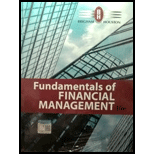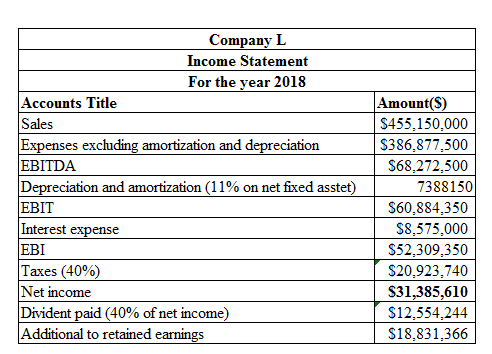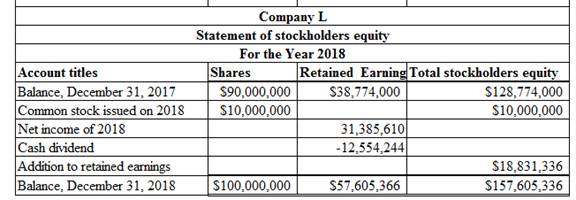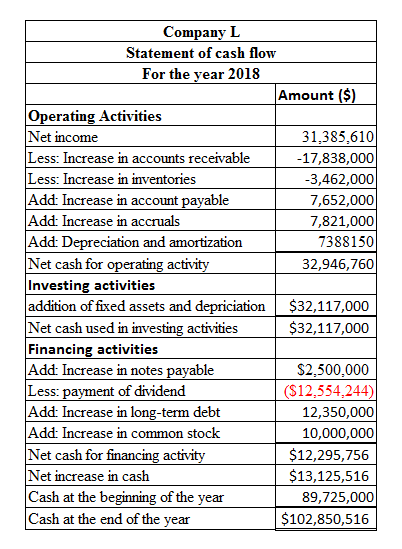
FINANCIAL STATEMENTS, CASH FLOW, AND TAXES Laiho Industries’s 2017 and 2018
| 2018 | 2017 | |
| Cash | $ 102,850 | $ 89,725 |
| Accounts receivable | 103,365 | 85,527 |
| Inventories | 38,444 | 34,982 |
| Total current assets | $ 244,659 | $ 210,234 |
| Net fixed assets | 67,165 | 42,436 |
| Total assets | $ 311,824 | $ 252,670 |
| Accounts payable | $ 30,761 | $ 23,109 |
| Accruals | 30,477 | 22,656 |
| Notes payable | 16,717 | 14,217 |
| Total current liabilities | $ 77,955 | $ 59,982 |
| Long-term debt | 76,264 | 63,914 |
| Total liabilities | $ 154,219 | $ 123,896 |
| Common stock | 100,000 | 90,000 |
| 57,605 | 38,774 | |
| Total common equity | $ 157,605 | $ 128,774 |
| Total liabilities and equity | $ 311,824 | $ 252,670 |
- a. Sales for 2018 were $ 455,150,000, and EBITDA was 15% of sales Furthermore,
depreciation and amortization were 11%. of net fixed assets, interest was $ 8,575,000, the corporate tax rate was 40%, and Laiho pays 40% of its net income as dividends Given this information. construct the firm’s 2018 income statement. - b. Construct the statement of stockholders’ equity for the year ending December 31, 2018, and the 2018 statement of cash flows.
- c. Calculate 2017 and 2018 net operating working capital (NOWC) and 2018
free cash flow (FCF). Assume the firm has no excess cash. - d. If Laiho increased its dividend payout ratio, what effect would this have on corporate taxes paid’ What effect would this have on taxis, paid by the company’s shareholders?
- e. Assume that the firm’s after-tax cost of capital is 10 5%. What is the firm’s 2018 EVA?
- f. Assume that the firm’s stock price is S22 per share and that at year-end 2018 the firm has 10 million shares outstanding. What is the firm’s MVA at year-end 2018?
a.
To prepare: The income statement of company L for 2014.
Financial Statements:
It refer to the statements, which are prepared by the firm at the closure of the accounting period in particular formats and are prescribed in the accounting to show its financial position.
Income Statement:
A part of financial statements that list the income and expenses of the business for an accounting year is called the income statement. It is prepared at the closure of the accounting period to know the profitability of the business.
Explanation of Solution
Given information:
Sales is $455,150,000 for the year 2018.
EBITDA is 15% on sales.
11% of depreciation and amortization on net fixed asset.
Interest is $8,575,000.
40% tax.
40% of the divided on net income.
Calculation on income statement using the spreadsheet is as follows:

Table (1)
Therefore, Company L has a net income of $31,385,610.
b.
To prepare: The statement of stockholders’ equity of Company L for 2018.
Statement of stockholders’ equity:
The statement of stockholders’ equity reports the opening and closing balance of stockholder’s equity with the changes incurred during the accounting period.
Statement of cash flow:
The statement of cash flow is a part of fiscal statements those are comprised in the yearly report of a company. It reports the cash generated or used by the business in a specified period.
Explanation of Solution
The calculation of statement of stockholders’ equity using the spreadsheet for the year 2018 is as follows:

Table (2)
The calculation of statement of cash flow using the spreadsheet is as follows:

Table (3)
c.
To compute: The net operating working capital for 2017 and 2018, and the free cash flow for 2018.
The net operating working capital:
The current assets and current liabilities of active business operations are known as the operating current assets and the operating current liabilities, respectively. The difference between these two is known as the net operating working capital.
Free Cash Flow:
The performance of a company’s operations is also evaluated by its cash generation abilities. The term used to depict and report that ability is known as the free cash flow. Capital expenditures are deducted from operating cash flow to compute the free cash flow.
Explanation of Solution
The calculation of net operating working capital is as follows:
Given information:
Current assets in 2017 are $210,234,000.
Current liabilities in 2017 are $59,982,000.
Current assets in 2018 are $244,659,000
Current liabilities in 2018 are $77,955,000.
For the year 2017,
The formula to compute the net operating current assets is as follows:
Compute the net operating current assets:
Hence, the net operating current asset is $210,234,000.
For the year 2017,
The formula to compute the net operating current liabilities is as follows:
Compute the net operating current liabilities:
Hence, the net operating current liabilities is $45,765,000.
For the year 2018,
The formula to compute the net operating current assets is as follows:
Compute the net operating current assets:
Hence, the net operating current asset is $244,659,000.
For the year 2018,
The formula to compute the net operating current liabilities is as follows:
Compute the net operating current liabilities:
Hence, the net operating current liabilities is $61,238,000.
For 2017,
The formula to compute the net operating working capital is as follows:
Substitute $210,234 for the net operating current assets and $45,765,000 for the net operating current liabilities.
Hence, the net operating working capital for the year 2017 is $164,469,000.
For 2018,
The formula to compute the net operating working capital is as follows:
Substitute $244,659 for current assets and $77,955 for the current liabilities.
Hence, the net operating working capital for the year 2018 is $183,421,000.
Calculation of Free cash flow:
Given information:
EBIT is $60,884,358 (refer part a).
The tax rate is 40%.
Depreciation is $7,388,150 (refer part a).
Capital expenditure is $32,117,000 (refer part b).
Increase in the net operating working capital is $18,952,000
The formula to compute the free cash flow is as follows:
Substitute $60,884 for EBIT, 40% for tax rate, $7,388 for depreciation, $32,117 for capital expenditure and $18,952,000.
Hence, the free cash flow for the year 2018 is -$7,150,235.2.
d.
To analyze: The effect of increased dividend payment on company’s tax liability and stockholders’ liability.
Dividend Payout Ratio:
The ratio that reflects the dividends paid as the proportion of net income earned by a company during a specified time period is called the dividend payout ratio.
Answer to Problem 19SP
There will be no change in the taxes paid by the company but the stockholders’ tax liability will increase with the increase in the dividend payout.
Explanation of Solution
- The dividend payment is calculated after the tax is calculated. Therefore, there will be no change in the tax amount if the dividend payment is changed.
- The dividend is an income for the stockholders and taxable for them. Therefore their tax liability will increase if the dividend payout is increased.
Therefore, the increased dividend payment will have no change in the company’s tax liability but it will increase the stockholders’ tax liability.
e.
To compute: The economic value added (EVA) for 2018.
Explanation of Solution
Given information:
EBIT is 60,884,350.
The capital invested is $250,586,000
The cost of capital is 10.5%.
The formula to compute EVA is as follows:
Substitute $31,386 for the earnings after tax, $157,605 for the capital invested, and 10.5% for the cost of capital.
Hence, the EVA for the year 2018 is $10,219,080.
f.
To compute: The market value added (MVA) for 2018.
Explanation of Solution
Given information:
The market price of a share is $22.
Outstanding shares are 10 million.
Common equity is $157,605,000.
The formula to compute MVA is as follows:
Substitute $22 for the market price of the share, $157,605 for the capital invested, and 10,000,000 for the number of shares.
Hence, the MVA for the year 2018 is $62,395,000.
Want to see more full solutions like this?
Chapter 3 Solutions
Bundle: Fundamentals of Financial Management, 15th + MindTap Finance, 1 term (6 months) Printed Access Card
- How has AirBnb negatively affected the US and global economy? How has Airbnb negatively affected the real estate market? How has Airbnb negatively affected homeowners and renters market? What happened to Airbnb in the Tax Dispute in Italy?arrow_forwardHow has AirBnb positively affected the US and global economy? How has Airbnb positively affected the real estate market? How has Airbnb positively affected homeowners and renters market?arrow_forwardD. (1) Consider the following cash inflows of a financial product. Given that the market interest rate is 12%, what price would you pay for these cash flows? Year 0 1 2 3 4 Cash Flow 160 170 180 230arrow_forward
- Explain why financial institutions generally engage in foreign exchange tradingactivities. Provide specific purposes or motivations behind such activities.arrow_forwardA. In 2008, during the global financial crisis, Lehman Brothers, one of the largest investment banks, collapsed and defaulted on its corporate bonds, causing significant losses for bondholders. This event highlighted several risks that investors in corporate bonds might face. What are the key risks an investor would encounter when investing in corporate bonds? Explain these risks with examples or academic references. [15 Marks]arrow_forwardTwo companies, Blue Plc and Yellow Plc, have bonds yielding 4% and 5.3%respectively. Blue Plc has a credit rating of AA, while Yellow Plc holds a BB rating. If youwere a risk-averse investor, which bond would you choose? Explain your reasoning withacademic references.arrow_forward
- B. Using the probabilities and returns listed below, calculate the expected return and standard deviation for Sparrow Plc and Hawk Plc, then justify which company a risk- averse investor might choose. Firm Sparrow Plc Hawk Plc Outcome Probability Return 1 50% 8% 2 50% 22% 1 30% 15% 2 70% 20%arrow_forward(2) Why are long-term bonds more susceptible to interest rate risk than short-term bonds? Provide examples to explain. [10 Marks]arrow_forwardDon't used Ai solutionarrow_forward
- Don't used Ai solutionarrow_forwardScenario one: Under what circumstances would it be appropriate for a firm to use different cost of capital for its different operating divisions? If the overall firm WACC was used as the hurdle rate for all divisions, would the riskier division or the more conservative divisions tend to get most of the investment projects? Why? If you were to try to estimate the appropriate cost of capital for different divisions, what problems might you encounter? What are two techniques you could use to develop a rough estimate for each division’s cost of capital?arrow_forwardScenario three: If a portfolio has a positive investment in every asset, can the expected return on a portfolio be greater than that of every asset in the portfolio? Can it be less than that of every asset in the portfolio? If you answer yes to one of both of these questions, explain and give an example for your answer(s). Please Provide a Referencearrow_forward
 Fundamentals Of Financial Management, Concise Edi...FinanceISBN:9781337902571Author:Eugene F. Brigham, Joel F. HoustonPublisher:Cengage Learning
Fundamentals Of Financial Management, Concise Edi...FinanceISBN:9781337902571Author:Eugene F. Brigham, Joel F. HoustonPublisher:Cengage Learning Financial Accounting: The Impact on Decision Make...AccountingISBN:9781305654174Author:Gary A. Porter, Curtis L. NortonPublisher:Cengage Learning
Financial Accounting: The Impact on Decision Make...AccountingISBN:9781305654174Author:Gary A. Porter, Curtis L. NortonPublisher:Cengage Learning


